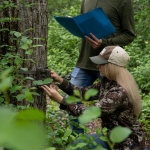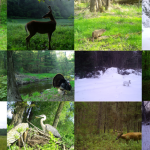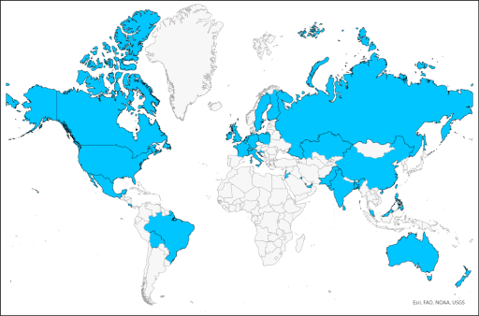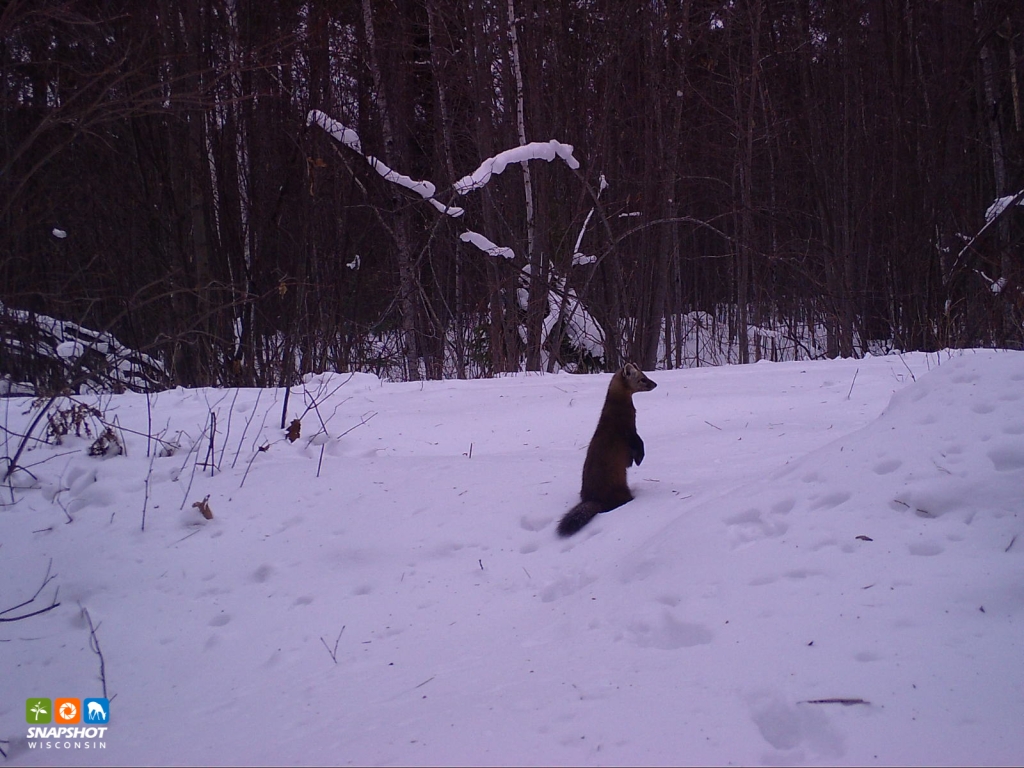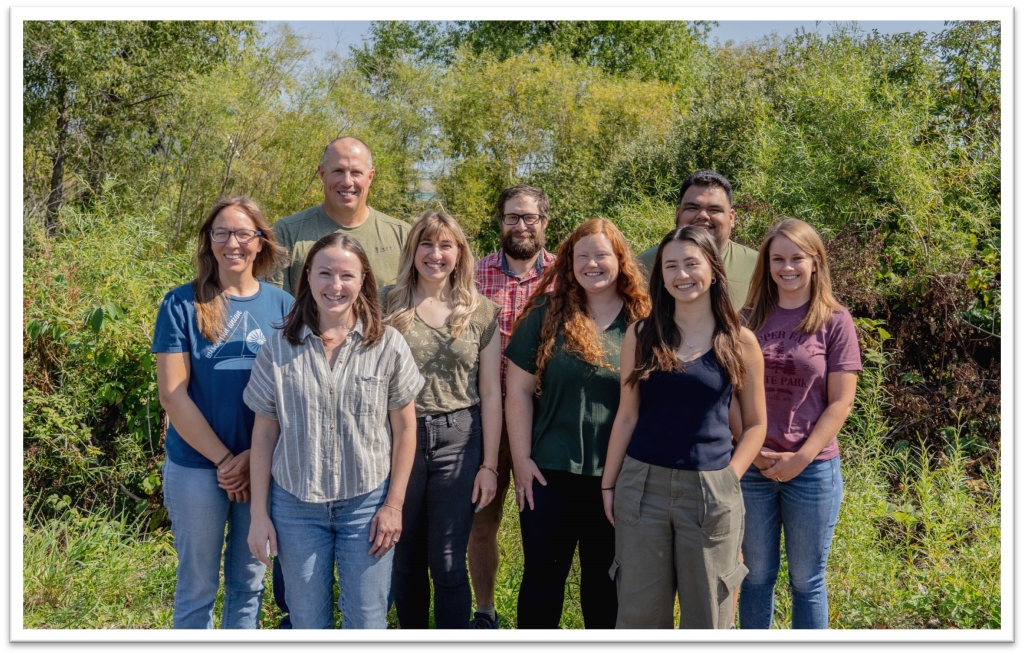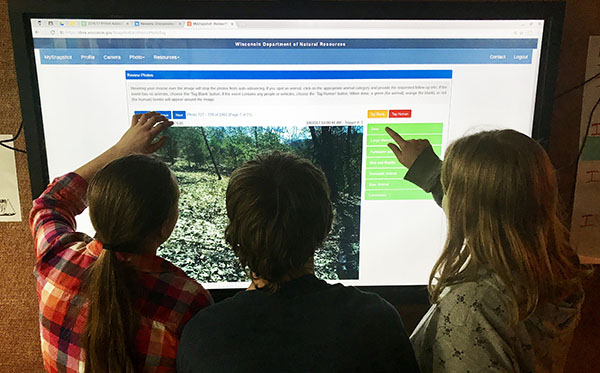Snapshot Wisconsin October 2024
Volunteer Impacts
Community science is a type of research that involves the public in scientific investigations, data collection, and analysis. You may as well use "Snapshot Wisconsin" as an example; see also "people-powered research." In this Snapshot newsletter edition, it's about you, the volunteers, and compiling the many impacts you have had on Wisconsin wildlife and research globally.
Would you like to receive Snapshot Wisconsin information and news sooner? Subscribe via GovDelivery and be the first to read the latest happenings with Snapshot Wisconsin and Wisconsin wildlife research.
- Snapshot Wisconsin Trail Camera Project - Sign up for emails about new Snapshot Wisconsin newsletters.
- Snapshot Wisconsin Educator's Bulletin - Sign up for emails about using Snapshot in classroom and outreach.
Volunteers Are The Heart of Snapshot
You've heard this before, but it's always worth saying again: Snapshot Wisconsin is people-powered research. We could not do this without you. See what impacts of the data volunteers have collected!
New Publication: Improving How We Measure Wildlife Diversity
Snapshot recently helped test a new tool that will help scientists around the world to measure wildlife diversity in ecosystems. This is an important measurement for tracking changes in biodiversity and monitoring the health of systems.
Snapshot Featured in Wisconsin Natural Resources Magazine
Featured in not one, but TWO fantastic articles that showcase how Snapshot contributes to current wildlife research and educating the next generation of wildlife enthusiasts.
Volunteers Are the Heart of Snapshot
Snapshot Wisconsin is a remarkable partnership between passionate wildlife enthusiasts and wildlife researchers, powered by the time and dedication of volunteers across Wisconsin and around the world. To sum up in a way that you’ve probably heard before, Snapshot Wisconsin is people-powered research.
Since 2015, this community science project has brought together trail camera hosts who install and monitor cameras in the field, online volunteers around the globe who classify those trail camera photos, and wildlife researchers who can use this data for ground-breaking research. Volunteers are the foundation of Snapshot, playing a crucial role in providing insights into Wisconsin’s wildlife, from deer to bears and everything in between.
Your hard work allows us to gather essential data that informs conservation efforts, species management, and wildlife research. Here are some incredible numbers to help acknowledge the hard work and effort of Snapshot volunteers:
- 1,956 trail camera hosts.
- 2,180 cameras deployed across the state.
- Over 20,252 hours of time were donated by camera hosts last year.
- Volunteers have collected an impressive 89,063,124 photos since the project launch (100 million, here we come!).
- More than 9 million classifications by Zooniverse volunteers online.
- Snapshot on Zooniverse continues to be one of the most popular projects on the site, with 21,800 users since Snapshot first started on the platform.
Alright, so how do all these impressive numbers translate to impacts? We could write a novel on that; in fact, we've written many Snapshot newsletter articles on the impact Snapshot volunteers have made in the world of wildlife research and management. We want to bring them all together to show just how much volunteers have helped accomplish, especially in the past few years.
Wildlife Research Contributions and Informing Species Management
From the efforts of volunteers collecting data and classifying images, Snapshot Wisconsin has become an important information resource for wildlife researchers, state agencies, and conservation efforts. For example, this incredible data informs how the WI DNR can sustainably manage species across Wisconsin. Data produced by Snapshot volunteers is actively being used in decision-making for 13 different species, with more applications in development by research scientists.
Here are a few examples of how Snapshot data is informing species management decisions:
Providing data for the Furbearer Advisory Committee for management decisions and sustainable harvest quotas on 10 furbearer species; we covered this in the January 2023 newsletter article, specifically on bobcats and fishers. The Furbearer Advisory Committee consists of representatives from government agencies, non-governmental organizations, tribal interests and conservation groups.
Ever thought, “ANOTHER deer on my camera/in this Zooniverse image?” All those deer images are an incredible help for Wisconsin deer management. Since 2017, DNR deer research scientists have been using Snapshot photo data to estimate deer fawn-to-doe ratios by county, among many other deer research topics. These are important measures to monitor the deer population and inform harvest quotas.
- New work is being done to generate turkey poult-to-hen ratios. An ongoing research project, supported by the WI DNR and Wisconsin Chapter of the National Wild Turkey Federation, which combines GPS transmitters and wing tags in conjunction with Snapshot trail camera images, to better understand turkey behavior, habitat preference and recruitment metrics that will be useful when making management decisions.
Snapshot volunteers also play an important role in detecting and monitoring rare species in Wisconsin, like moose, marten, whooping crane, and cougar. These findings are then reported to agencies and partner organizations, like the International Crane Foundation or Natural Heritage Conservation, that help monitor or study these rare species. In the past year alone, Snapshot cameras have detected a pine marten (Bayfield County) and a moose (Vilas County). In 2023, a Snapshot camera even captured an image of the federally endangered whooping crane (Jackson County)!
In addition, volunteer-collected data contribute to scientific research worldwide, furthering our understanding of wildlife biology, ecology, and behavior. In the past year alone, Snapshot data has contributed to four new scientific publications, which can be seen with all other scientific papers from the project on our Scientific Publications webpage. You’ll read in the following article about the most recent paper, where Snapshot data was used to test a new tool that will help scientists around the world better measure wildlife diversity in ecosystems.
Educational Resources: Teaching Future Generations
Not only does Snapshot data inform species management, but it is also available to the public via the Data Dashboard. The Data Dashboard has been an incredible resource for interacting with and downloading Snapshot Wisconsin data. Most recently, data for three new species were also added (gray fox, beaver, and otter) were also added. Read why these three species were added this year in the August 2024 newsletter.
The Dashboard provides wildlife data that can be used in classrooms (see our last article in this newsletter), for student projects, undergrads, or even just to provide great info on a lot of Wisconsin wildlife—for free. Snapshot Wisconsin also offers free classroom activities that use the Data Dashboard or Snapshot trail camera images to teach about wildlife, ecology, and biology. This is only possible because of the hard work of volunteers gathering that data and the educators who helped create or pilot these activities.
From the Volunteers
We love meeting Snapshot volunteers in person and hearing about their experiences. Recently, we chatted with some volunteers at one of our in-person volunteer recognition events. Here are a few of the many wonderful, inspiring comments we received:
“Quiet observation is extremely rewarding and always adds to my appreciation and understanding of why I practice land stewardship and love nature.”
“I have been involved with Snapshot since Oct. 2018. After six years I am continually amazed at the diversity of critters from black bears, bobcats to grouse and fishers. It is fun!”
“It's been amazing to get a glimpse of our wild treasures via the Snapshot lens. Satisfying to help advance wildlife research in the digital age.” -Matt Dettlaff
“My wife and I service the cameras together, it's a time we can be together walking in the woods.” -Dave Bjorge
“I really enjoy sharing my picture captures with family and friends. It's very gratifying to help others connect with the animals around us.” -Nola Risse-Connolly
“Having the camera and capturing the wildlife in my own backyard, gives me a new appreciation of the work done by DNR to keep our wildlife healthy and manageable.” -Dan Roman
“The Snapshot team has always been very helpful and easy to work with. I always anxiously await the return of my photos after upload. It's so fun to see what they captured.”
“It is rewarding being part of this team, providing data and observations to better our state's wildlife.” -Fred Robinson
“We love the program! So fun to see all the photos of what animals go through our woods.” -Bob & Teri Panzer
“Hosting a Snapshot camera has enhanced our appreciation of the variety of wildlife in our northern Wisconsin woods. Contributing to citizen science has been memorable and rewarding.”
“Snapshot is a great platform for wildlife enthusiasts, like me!”
“Knowing that I can be of help to the naturalist community to better understand and plan conservation efforts of our state is the most inspiring aspect.”
“Every time I start to think it is time to pass the camera on, something neat happens and I get all excited again!”
Thank You from the Team
All the accomplishments and numbers listed above would not have been possible without you, the volunteers. Whether you host a trail camera or classify images online, you contribute to the Snapshot dataset that is making a difference.
Thank you for making this program a success and helping provide a public resource that monitors Wisconsin wildlife species, informs species management, and educates future generations on the natural world around them. Thank you to each volunteer for your time, effort, and dedication to helping Snapshot Wisconsin thrive!
-The Snapshot Wisconsin Team
New Scientific Publication Using Snapshot Data: Improving How We Measure Wildlife Diversity
Snapshot Wisconsin contributed data to a study investigating ways to better estimate wildlife species diversity, and that study recently released a scientific publication!
Species diversity is the variety of different species of animals present in a specific area or ecosystem, and high diversity often indicates a healthy ecosystem. Wildlife diversity indices are mathematical measures used to help determine species diversity. When indices are used with trail camera data, scientists can measure biodiversity in an area, provide a comprehensive view of a wildlife community, and track changes in biodiversity over time.
However, there are some challenges in using cameras to accurately estimate population diversities across different species, mostly due to the varying levels of detectability (think of the detectability of the deer vs ruffed grouse in the above image) and population densities in most wildlife communities. Snapshot Wisconsin data was used in a case study to test a new diversity index that could help overcome these challenges. Authors listed in bold are Snapshot Wisconsin team members.
Fractional Richness: An index for camera trap networks
Berman, L.M., Schneider, F.D., Pavlick, R.P., Stenglein, J.L., Bemowski, R., Dean, M., Townsend, P.A.
Key Findings:
- Camera traps face challenges in estimating wildlife diversity due to varying species detectability and differences in population densities, particularly across levels in the food chain and body sizes.
- Traditional diversity measures often assume there is a balanced species distribution, and struggle to measure diversity when not all species are equally easily detected or when population densities vary.
- A new index, Fractional Richness, may help better understand wildlife diversity in uneven wildlife communities, where species are not equally abundant or detected.
- Fractional Richness performed better than traditional indices when used in a case study with Snapshot Wisconsin data, providing more accurate assessments of landscape patterns, especially when species detectability varies.
Improving wildlife diversity indices when used with trail camera data can help scientists better identify population trends, track the overall health of an ecosystem, and inform conservation efforts. Are you curious about all the ways Snapshot Wisconsin has contributed to wildlife research? Visit Snapshot Wisconsin publications to learn more!
Snapshot Featured In Wisconsin Natural Resources Magazine
Your time and dedication help Snapshot be an incredible resource in multiple ways. This Fall, the Wisconsin DNR's Natural Resources Magazine included two articles highlighting Snapshot work: Snapshot Brings Wildlife Learning to the Classroom and Wild Ride for Wisconsin Turkeys!
Lessons in Nature
Lessons in Nature, written by Jonna Mayberry, explored the unique ways in which Snapshot has been incorporated into Wisconsin classrooms by highlighting Peter Dargatz and Skylar Primm, Snapshot volunteers and seasoned educators. Dargatz, a kindergarten teacher at Woodside Elementary School in Sussex, WI, said that he and his students start out the school year by practicing simple animal IDs before eventually working their way up to talking about seasons and animal behavior.
Another educator, Skylar Primm, is a lead teacher at Koshkonong Trails School in Cambridge, WI, where the school maintains a Snapshot trail camera on the grounds. Primm explained that this not only gives students a chance to see nature behind the scenes and in their own backyard but also serves as a valuable tool for discussing ecological concepts like life cycles.
We would like to thank Peter Dargatz and Skylar Primm for taking time out of their busy schedules to be interviewed for this piece and for continuing to collaborate with Snapshot Wisconsin. If you or someone you know is interested in incorporating Snapshot into education, you can visit Snapshot in the Classroom for curriculum ideas and other fun activities!
Wild Ride for Wisconsin Turkeys
This fall article written by Caitlyn Nalley features all things turkey! After giving a brief rundown on the history of this wild game bird’s management in Wisconsin, it discusses innovative wildlife research being contributed to by Snapshot. WI DNR research scientist Chris Pollentier is currently the lead on a new project studying wild turkey movement and detectability. To do this, Pollentier and his team are combining turkey detections and brood counts captured by Snapshot trail cameras with on-the-ground radio tagging and monitoring. The goal is to see if incorporating trail camera data like Snapshots will allow scientists to estimate poult-to-hen ratios more accurately and efficiently, and, thus, better inform management decisions.
This project is ongoing and set to continue through 2026, but anyone interested in learning more can do so by visiting the project summary! Additionally, both the above articles and past editions of the magazine, can always be read in full on the DNR’s Natural Resource Magazine webpage.

